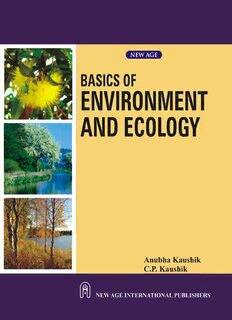
Basics of environment and ecology PDF
Preview Basics of environment and ecology
This page intentionally left blank Copyright © 2010, New Age International (P) Ltd., Publishers Published by New Age International (P) Ltd., Publishers All rights reserved. No part of this ebook may be reproduced in any form, by photostat, microfilm, xerography, or any other means, or incorporated into any information retrieval system, electronic or mechanical, without the written permission of the publisher. All inquiries should be emailed to [email protected] ISBN (13) : 978-81-224-2856-8 PUBLISHING FOR ONE WORLD NEW AGE INTERNATIONAL (P) LIMITED, PUBLISHERS 4835/24, Ansari Road, Daryaganj, New Delhi - 110002 Visit us at www.newagepublishers.com Preface Exponential growth of human population coupled with ways to attain high standards of living through technological advancement has resulted in widespread contamination of the environment at the global level. During the past few decades, rapid industrialization, wanton exploitation of natural resources and excessive use of environmentally abhorrent materials have resulted in discernible environmental disruptions threatening the life support system. Such changes may jeopardize the very existence of life on this planet which evolved over millions of years. During these years millions of species of microorganisms, plants and animals co-evolved, the most intelligent of them being the human being, who eventually became the master of all other species and started exploiting them. Human-centric approach of development has already damaged the nature to a large extent. This has caught attention of scientists, academicians, social scientists, policy makers and the like necessitating discussions at various international fora. The objective of environmental protection cannot be achieved without involvement of the masses at the grass root level. In this book basic concepts of Environment and Ecology have been introduced and analysed in a simple manner for under graduate classes in all disciplines. Key features of the book include a simple and holistic approach with illustrations, tables and specific case studies. The basic terminologies have been defined in the text while introducing the topics and some useful terms mentioned in the text have been explained in the glossary for an easy grasp by students of all disciplines. We are indebted to all the scientists, scholars and grass-root level workers in the field of environmental studies whose work and observations form the basis of our understanding of various scientific and social aspects of environment. We thank M/S. New Age International (P) Ltd., Publishers, New Delhi for their wonderful work in bringing out this edition of the book in its present form. • Anubha Kaushik C.P. Kaushik (nee Sinha) This page intentionally left blank Contents Preface 1. ENVIRONMENT AND ECOLOGY.........................................................................1–13 1.1 Introduction ...........................................................................................................................1 1.2 Scope .....................................................................................................................................2 1.3 Importance of Environment...................................................................................................3 1.4 Need for Public Awareness....................................................................................................5 1.5 Concept of Ecology and Ecosystem......................................................................................7 1.6 Balanced Ecosystem ..............................................................................................................9 2. HUMAN IMPACTS ON ENVIRONMENT............................................................14–27 2.1 Introduction..............................................................................................................................14 2.2 Major Aspects of Human Activities ..........................................................................................14 2.3 Effects of Human Activities on Environment...........................................................................16 3. ENVIRONMENTAL IMPACT ASSESSMENT AND SUSTAINABLE DEVELOPMENT ..................................................................................................28–36 3.1 Introduction..............................................................................................................................28 3.2 Environmental Impact Assessment (EIA) ................................................................................28 3.3 Sustainable Development.........................................................................................................32 4. NATURAL RESOURCES.......................................................................................37–56 4.1 Water Resources.......................................................................................................................37 4.2 Availability and Quality Aspects..............................................................................................37 4.3 Water Borne and Water Induced Diseases................................................................................43 4.4 Fluoride Problem in Drinking Water........................................................................................45 4.5 Mineral Resources....................................................................................................................48 4.6 Forest Wealth............................................................................................................................50 4.7 Material Cycles.........................................................................................................................52 CONTENTS 5. ENERGY..............................................................................................................57–71 5.1 Introduction..............................................................................................................................57 5.2 Types of Energy Resources .....................................................................................................57 5.3 Electromagnetic Radiations ......................................................................................................58 5.4 Conventional Energy Resources (Fossil Fuel Based)...............................................................59 5.5 Non-Conventional Energy Sources ..........................................................................................63 6. ENVIRONMENTAL POLLUTION........................................................................72–92 6.1 Water Pollution .........................................................................................................................72 6.2 Land Pollution...........................................................................................................................76 6.3 Noise Pollution..........................................................................................................................78 6.4 Public Health Aspects ...............................................................................................................82 6.5 Air Pollution..............................................................................................................................84 6.6 Solid Waste Management..........................................................................................................88 7. CURRENT ENVIRONMENTAL ISSUES OF IMPORTANCE..............................93–114 7.1 Population Growth....................................................................................................................93 7.2 Climate Change......................................................................................................................100 7.3 Global Warming .....................................................................................................................101 7.4 Acid Rain................................................................................................................................104 7.5 Ozone Layer Depletion...........................................................................................................107 7.6 Urbanization...........................................................................................................................108 7.7. Automobile Pollution .............................................................................................................109 7.8 Animal Husbandry.................................................................................................................. 110 8. ENVIRONMENTAL PROTECTION ..................................................................115–128 8.1 Role of Government............................................................................................................... 115 8.2 Legal Aspects......................................................................................................................... 116 8.3 Initiatives by Non-governmental Organizations.....................................................................122 8.4 Environmental Education.......................................................................................................124 8.5 Women Education...................................................................................................................125 SUGGESTED READINGS.................................................................................129–130 GLOSSARY.......................................................................................................131–139 INDEX .............................................................................................................141–146 (cid:1) (cid:1)(cid:2)(cid:3)(cid:4)(cid:5)(cid:6)(cid:2)(cid:7)(cid:8)(cid:2)(cid:9)(cid:10)(cid:11)(cid:2)(cid:12)(cid:10)(cid:1)(cid:13)(cid:6)(cid:14)(cid:6)(cid:15)(cid:16) (cid:1)(cid:2)(cid:1) (cid:3)(cid:4)(cid:5)(cid:6)(cid:7)(cid:8)(cid:9)(cid:10)(cid:5)(cid:3)(cid:7)(cid:4) ‘Environment’ is a term derived from the French word ‘Environner’ that means ‘to surround’. There was a time when environment just meant surroundings. It was used to describe the physical world surrounding us including soil, rocks, water and air. Gradually it was realized that the enormous variety of plants, animals and micro-organisms on this earth, including human beings are an integral part of the environment. Hence, to make a sensible definition of environment, it was necessary to include the interactions and inter-relationships of all living organisms with the physical surroundings. Later, it was further recognised that all types of social, cultural and technological activities carried out by human beings also have a profound influence on various components of the environment. Thus various built structures, materials and technological innovations also became a part of the environment. So now all biological (biotic) and non-biological (abiotic) entities surrounding us are included in the term ‘environment’. The impact of technological and economic development on the natural environment may lead to degradation of the social and cultural environment. Thus, environment is to be considered in a broader perspective where the surrounding components as well as their interactions are to be included. As per Environment (Protection) Act, 1986, environment includes all the physical and biological surroundings of an organism along with their interactions. Environment is thus defined as “the sum total of water, air and land and the inter-relationships that exist among them and with the human beings, other living organisms and materials.” The concept of environment can be clearly understood from Fig. 1.1. Figure 1.1 depicts the environment of human beings. Air, water and land surrounding us constitute our environment, and influence us directly. At the same time we too have an influence on our environment due to overuse or over-exploitation of resources or due to discharge of pollutants in the air, water and land. The flora, fauna and micro-organisms as well as the man-made structures in our surroundings have a bi-directional interaction with us directly or indirectly. The totality of all these components and their interactions constitute the environment. (cid:1)
